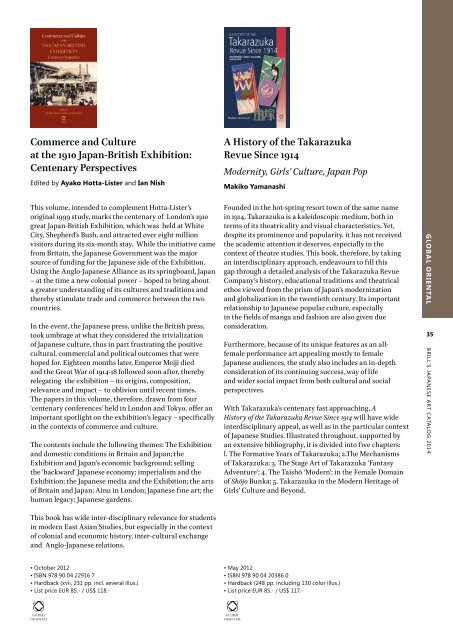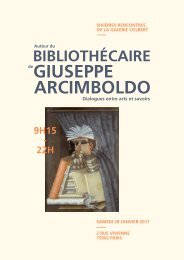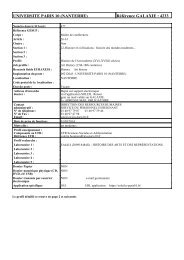japanese_art_catalog
japanese_art_catalog
japanese_art_catalog
Create successful ePaper yourself
Turn your PDF publications into a flip-book with our unique Google optimized e-Paper software.
Commerce and Culture<br />
at the 1910 Japan-British Exhibition:<br />
Centenary Perspectives<br />
Edited by Ayako Hotta-Lister and Ian Nish<br />
A History of the Takarazuka<br />
Revue Since 1914<br />
Modernity, Girls’ Culture, Japan Pop<br />
Makiko Yamanashi<br />
This volume, intended to complement Hotta-Lister’s<br />
original 1999 study, marks the centenary of London’s 1910<br />
great Japan-British Exhibition, which was held at White<br />
City, Shepherd’s Bush, and attracted over eight million<br />
visitors during its six-month stay. While the initiative came<br />
from Britain, the Japanese Government was the major<br />
source of funding for the Japanese side of the Exhibition.<br />
Using the Anglo-Japanese Alliance as its springboard, Japan<br />
– at the time a new colonial power – hoped to bring about<br />
a greater understanding of its cultures and traditions and<br />
thereby stimulate trade and commerce between the two<br />
countries.<br />
In the event, the Japanese press, unlike the British press,<br />
took umbrage at what they considered the trivialization<br />
of Japanese culture, thus in p<strong>art</strong> frustrating the positive<br />
cultural, commercial and political outcomes that were<br />
hoped for. Eighteen months later, Emperor Meiji died<br />
and the Great War of 1914-18 followed soon after, thereby<br />
relegating the exhibition – its origins, composition,<br />
relevance and impact – to oblivion until recent times.<br />
The papers in this volume, therefore, drawn from four<br />
‘centenary conferences’ held in London and Tokyo, offer an<br />
important spotlight on the exhibition’s legacy – specifically<br />
in the contexts of commerce and culture.<br />
The contents include the following themes: The Exhibition<br />
and domestic conditions in Britain and Japan; the<br />
Exhibition and Japan’s economic background; selling<br />
the ‘backward’ Japanese economy; imperialism and the<br />
Exhibition; the Japanese media and the Exhibition; the <strong>art</strong>s<br />
of Britain and Japan; Ainu in London; Japanese fine <strong>art</strong>; the<br />
human legacy; Japanese gardens.<br />
This book has wide inter-disciplinary relevance for students<br />
in modern East Asian Studies, but especially in the context<br />
of colonial and economic history, inter-cultural exchange<br />
and Anglo-Japanese relations.<br />
Founded in the hot-spring resort town of the same name<br />
in 1914, Takarazuka is a kaleidoscopic medium, both in<br />
terms of its theatricality and visual characteristics. Yet,<br />
despite its prominence and popularity, it has not received<br />
the academic attention it deserves, especially in the<br />
context of theatre studies. This book, therefore, by taking<br />
an interdisciplinary approach, endeavours to fill this<br />
gap through a detailed analysis of the Takarazuka Revue<br />
Company’s history, educational traditions and theatrical<br />
ethos viewed from the prism of Japan’s modernization<br />
and globalization in the twentieth century. Its important<br />
relationship to Japanese popular culture, especially<br />
in the fields of manga and fashion are also given due<br />
consideration.<br />
Furthermore, because of its unique features as an allfemale<br />
performance <strong>art</strong> appealing mostly to female<br />
Japanese audiences, the study also includes an in-depth<br />
consideration of its continuing success, way of life<br />
and wider social impact from both cultural and social<br />
perspectives.<br />
With Takarazuka’s centenary fast approaching, A<br />
History of the Takarazuka Revue Since 1914 will have wide<br />
interdisciplinary appeal, as well as in the p<strong>art</strong>icular context<br />
of Japanese Studies. Illustrated throughout, supported by<br />
an extensive bibliography, it is divided into five chapters:<br />
l. The Formative Years of Takarazuka; 2.The Mechanisms<br />
of Takarazuka; 3. The Stage Art of Takarazuka ‘Fantasy<br />
Adventure’; 4. The Taishō ‘Modern’; in the Female Domain<br />
of Shōjo Bunka; 5. Takarazuka in the Modern Heritage of<br />
Girls’ Culture and Beyond.<br />
GLOBAL ORIENTAL<br />
35<br />
BRILL’S JAPANESE ART CATALOG 2014<br />
• October 2012<br />
• ISBN 978 90 04 22916 7<br />
• Hardback (xvii, 231 pp. incl. several illus.)<br />
• List price EUR 85.- / US$ 118.-<br />
• May 2012<br />
• ISBN 978 90 04 20386 0<br />
• Hardback (248 pp. including 130 color illus.)<br />
• List price EUR 85.- / US$ 117.-






